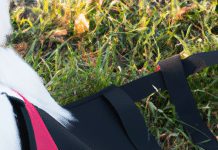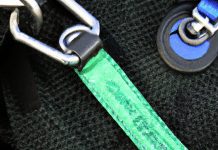Thinking about introducing your dog to wearing a harness? We understand that it can be a slightly daunting task, especially if your four-legged friend is not used to wearing any type of clothing or gear. But fear not, we are here to guide you through the process and make it as smooth as possible. In this article, we will share some tips and tricks on how to introduce your dog to wearing a harness for the first time, helping you and your canine companion take that exciting step together. So, let’s get started on this exciting new adventure!
Choosing the Right Harness
Choosing the right harness for your dog is an important step in ensuring their comfort and safety. To start, you’ll need to measure your dog for the correct size. Every dog is unique, so it’s essential to take accurate measurements to find a harness that fits properly. Measure the circumference of your dog’s chest, just behind their front legs. This measurement will give you an idea of the size range you should be looking for.
Once you have the correct measurements, consider the type of harness that will best suit your dog’s needs. There are different styles, such as step-in harnesses, overhead harnesses, and front-clip harnesses. Each has its advantages and may be suitable for different situations or dogs with specific needs. Take some time to research the different options and choose one that you believe will work well for your furry friend.
When selecting a harness, it’s also important to look for adjustable straps and secure closures. Adjustable straps ensure a proper fit and allow you to customize the harness to your dog’s unique body shape. Secure closures, such as buckles or clasps, will ensure that the harness stays securely in place during walks or any activity. These features are crucial for both comfort and safety.
Familiarizing Your Dog with the Harness
Before putting the harness on your dog for the first time, it’s helpful to give them an opportunity to sniff and investigate it. Dogs rely heavily on their sense of smell, so this step can help them become more comfortable with the new gear. Allow your dog to approach the harness, sniff it, and explore it at their own pace. This will help to create a positive association with the harness and reduce any initial apprehension.
To further reinforce positive associations, be sure to reward your dog during the familiarization process. Use treats, praise, and other rewards to let them know that the harness is a good thing. By associating the harness with positive experiences, your dog will be more likely to view it as something positive in the future.
Gradual introduction is key when it comes to familiarizing your dog with the harness. Start by putting the harness on for short periods of time in a calm and relaxed environment. Allow your dog to wear the harness while engaging in activities they enjoy, such as playing with toys or receiving affection. These short sessions will help your dog adjust to the new sensation of wearing a harness without overwhelming them.
Putting on the Harness
When it’s time to put the harness on your dog, it’s essential to create a calm and relaxed environment. Dogs are sensitive to their owner’s emotions, so remaining calm and collected will help your furry friend feel at ease. Choose a quiet area where you can focus on the task at hand without distractions.
To make the experience more enjoyable for your dog, give them treats and positive reinforcement while you put the harness on. Offer a treat and praise when your dog allows you to put the harness on without resistance. This positive reinforcement will help your dog associate putting on the harness with good things.
Remember to take it slow and be patient. Some dogs may take a little longer to get used to the harness than others. If your dog shows signs of discomfort or resistance, stop and take a break. You can resume the process later when your dog is more relaxed. It’s vital to work at your dog’s pace and not rush them into accepting the harness.
Adjusting the Fit
Once the harness is on your dog, it’s crucial to ensure a snug fit without restricting their movement. The harness should fit securely and comfortably around your dog’s body, allowing them to move freely. Check that the straps are not too loose or too tight, ensuring a proper fit. A loose harness may lead to your dog slipping out, while a tight harness can cause discomfort and restrict their natural movement.
Positioning and alignment are equally important when adjusting the fit of the harness. The harness should sit high on your dog’s chest and avoid pressing on their throat area. Ensure that the straps are not twisted or tangled and that the closures are secure. Proper positioning and alignment will help distribute the pressure evenly and provide optimal comfort for your dog.
Make adjustments as needed. As your dog grows or gains/loses weight, you may need to adjust the harness accordingly. Regularly check the fit of the harness and make any necessary modifications to ensure it continues to fit properly.
Getting Your Dog Used to Wearing the Harness
Once the harness is properly fitted, it’s time to get your dog used to wearing it for longer periods. Encourage your dog to move around with the harness on, allowing them to become familiar with the sensation of having it on their body. Engage in fun activities while your dog wears the harness, such as playing fetch or going for short walks. By associating the harness with enjoyable experiences, your dog will be more accepting of wearing it.
Gradually increase the duration of harness wearing. Start by having your dog wear the harness for short periods and gradually extend the time. This gradual increase will help your dog become accustomed to wearing the harness for longer periods without feeling overwhelmed. Remember to monitor your dog for any signs of discomfort or distress and adjust the duration accordingly.
Troubleshooting Common Issues
Sometimes, dogs may exhibit resistance or reluctance when it comes to wearing a harness. It’s important to address these issues with patience and understanding. If your dog resists wearing the harness, take a step back and reassess the situation. Evaluate whether there are any underlying reasons for their resistance, such as previous negative experiences or fear. Addressing these underlying issues may help resolve the resistance.
If your dog shows signs of discomfort while wearing the harness, it’s essential to address the source of the discomfort. Check the fit of the harness and make sure it’s not too tight or causing any rubbing or irritation. If discomfort persists, consider consulting a professional, such as a veterinarian or a dog trainer, for further guidance.
In some cases, seeking professional guidance may be necessary. If you are struggling to introduce the harness to your dog or are experiencing significant difficulties, a professional can provide valuable insights and assistance. They can assess your dog’s specific needs and guide you through the process in a way that is safe and effective.
Taking Your Dog for a Walk
Once your dog has become comfortable wearing the harness, it’s time to take them for a walk. However, before venturing outside, it’s a good idea to practice walking indoors first. This allows your dog to get used to walking with the harness on in a controlled environment, minimizing distractions and potential challenges.
During outdoor walks, use positive reinforcement to encourage good behavior from your dog. Praise and reward your dog for walking calmly and staying by your side. This positive reinforcement will make the experience enjoyable for your dog and reinforce their good behavior.
Keep in mind that every dog is different, and their behavior may vary during walks. Pay attention to your dog’s behavior and adjust your approach accordingly. If your dog pulls or becomes reactive during walks, consider seeking guidance from a professional dog trainer who can help you address these behaviors in a positive and effective manner.
Maintaining the Harness
Regular maintenance and care of the harness are essential for its longevity and your dog’s safety. Make it a habit to regularly check the harness for any signs of wear and tear. Look for frayed straps, loose threads, or damaged closures. If you notice any issues, it may be time to replace the harness to ensure your dog’s safety.
Cleaning the harness regularly is also important. Follow the manufacturer’s instructions for cleaning and care. Some harnesses may be machine washable, while others may require hand washing. Proper cleaning will help keep the harness in good condition and prevent any build-up of dirt or bacteria.
As your dog grows or changes shape, it’s important to reassess the fit of the harness periodically. Make sure the harness continues to fit properly and make any necessary adjustments. A well-fitting harness is crucial for your dog’s comfort and safety during any activity.
Introducing Other Activities with the Harness
Once your dog is comfortable wearing the harness and walking outdoors, you can introduce them to other activities while wearing it. This may include car rides, outdoor adventures, or participating in sports such as agility training or hiking. Gradually expose your dog to different environments and activities, allowing them to adjust at their own pace.
When introducing car rides, ensure that your dog is safely secured in the vehicle. Using the harness along with a seat belt attachment or a specialized dog car seat can help keep your dog secure and minimize the risk of injury during car rides.
Engage in outdoor adventures with your dog while they wear the harness. This may include hiking, running, or playing at the beach. Always consider your dog’s safety and well-being during these activities, and monitor them closely to ensure they are comfortable and enjoying themselves.
Conclusion
Introducing your dog to wearing a harness for the first time requires patience, understanding, and positive reinforcement. By following the steps outlined in this article, you can help your dog become comfortable with wearing a harness and make the experience a positive one. Remember to choose the right harness, familiarize your dog gradually, and make adjustments as needed. With time and practice, your dog will become accustomed to wearing a harness and will be ready to enjoy walks, adventures, and other activities with you.






























